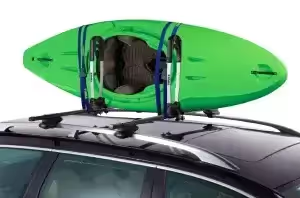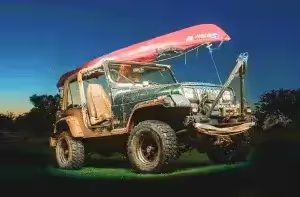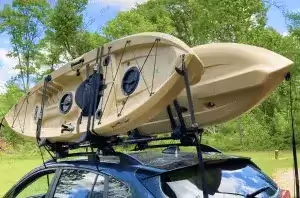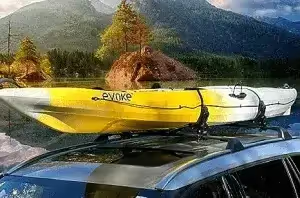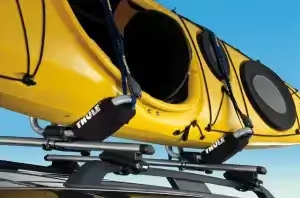No Rack? Here's How to Tie a Canoe to Your Car
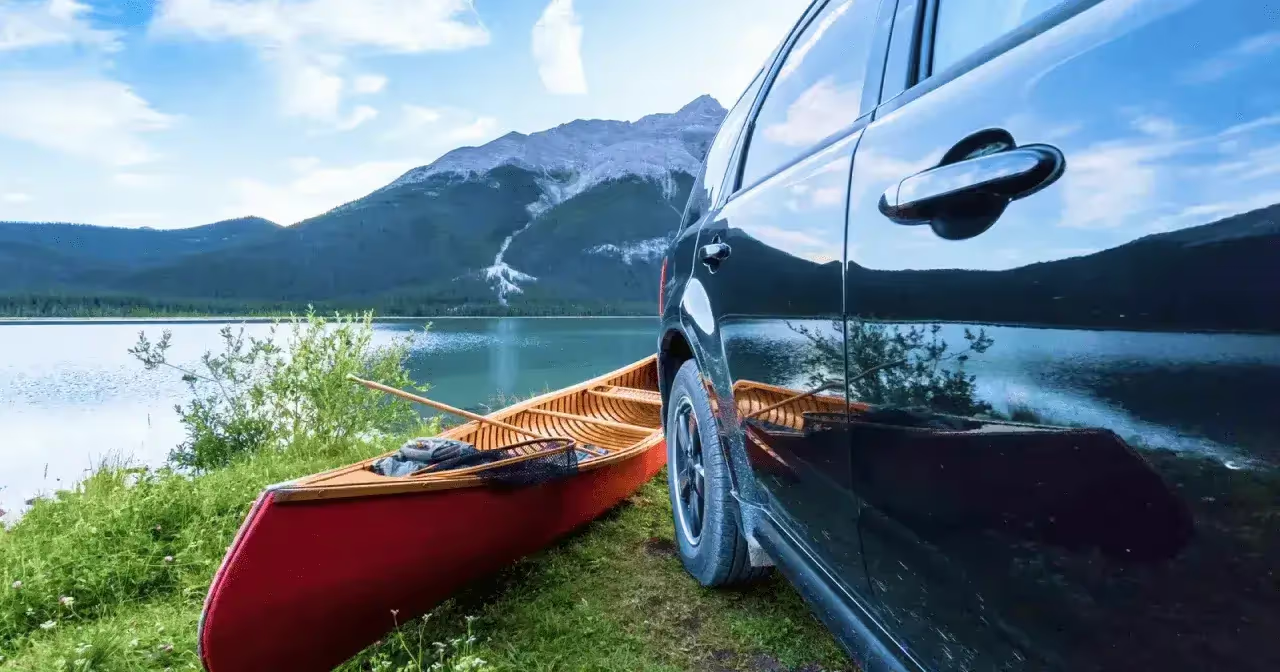
When I got my first car, I had to tie a canoe without rack to do a long weekend portaging trip with my friends. That was my first experience transporting canoes. In the last 7 years, I have been a white water instructor, and today, I'll share the tips and recommendations I've learned in the field with you.
How do you transport your kayak to the closest river or lake if you don't have a roof rack system? How can you do it safely?
The best way to transport your canoe is with a roof rack system, but they can be expensive. If you don’t use your canoe very often or you just need to make a short trip, it might not be worth investing in a complete roof rack system.
Before we get into what you need, watch this. Frontenac Outfitters put together a very informative overview.
In this article, I'll walk you through the step-by-step process, providing you with all the information you need to transport your canoe with confidence.
What You’ll Need to Strap Your Canoe
Before tying a canoe to your car without a roof rack, you’ll need a few items.
If you try to strap your canoe to your roof without the right materials, you risk damaging your vehicle roof, scratching paint and possibly shattering a window!
That's why, I'll walk you through the step-by-step process, providing you with all the information you need to transport your canoe with confidence.
Foam Blocks or Pool Noodles
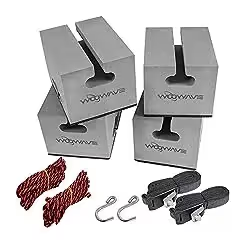
The canoe will be placed on top of the foam blocks, or pool noodles, to prevent your roof from being damaged.
It will also help prevent the canoe from slipping while you’re driving.
Foam blocks are recommended because they are designed specifically for carrying canoes, but if you want to save money you can do this with pool noodles.
This foam block kit by WOOWAVE is great and affordable. It also includes buckle straps and tie-down ropes!
Cam Buckle Straps or Ratchet Straps

You’ll also need some straps to tie the canoe to your roof. You can use either cam buckle straps or ratchet straps.
While cam buckle straps are easier to use, ratchet straps provide better strength and stability.
You’ll need at least 2 straps to secure your canoe properly.
Tie-Down Ropes
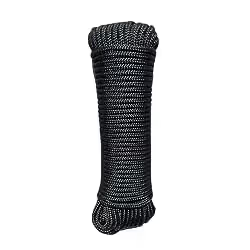
Just like cam buckle/ratchet straps, tie-down ropes also help secure the canoe onto the roof of your car. They come in different thicknesses, however, the 1-1/4 is the most popular and recommended because it’s sturdy enough to secure a heavy load.
Tie-down ropes and straps can be used interchangeably, but the best option is to use both ropes and straps to tie your canoe to your roof.
Hood and Trunk Tie-Down Loops
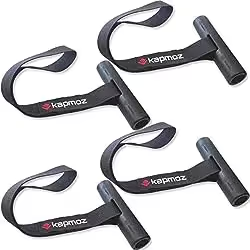
Although these are optional, they are highly recommended.
They are quick to install and remove. Ideal for vehicles without the built-in tie-down points but further away from the vehicle surface to avoid damage and deter scratches.
Tie-down loops will allow you to secure your canoe to the hood and trunk for extra stability. This will prevent the canoe from shifting during acceleration and braking.
Also check out: Hitch Canoe Rack Buyer’s Guide
Mounting and Securing the Canoe
Before you start tying your canoe to a car without a roof rack, you’ll want to keep a few things in mind.
The goal is to prevent the canoe from moving forward, backward, or side-to-side during transport. It should not bounce up and down either. This is what you’ll be trying to achieve.
Tying down the bow and stern will prevent the canoe from moving back and forth, and doing so in a “V” pattern will stop it from moving sideways. For example, attaching tie-downs to the bow of the canoe and the left and right ends of the hood would create this “V” shape.
You should also secure it across the center of the canoe which will help prevent bouncing.
Step 1: Loading the Canoe
First, we need to carefully place the canoe on top of the car.
Before doing this. make sure your foam blocks or pool noodles are already in place. If you are using foam blocks, you’ll be affixing them along the gunwales (the edges of the canoe).
Once the foam blocks are in position, you can lift the canoe and place it on top of the vehicle. Although it is possible to load the canoe onto the car by yourself, it’s a daunting task that can damage your canoe and vehicle if done incorrectly. It’s better to get help from someone else if you can.
The pool noodles will \serve the same function as the foam blocks, but they need not be affixed to the gunwales. The canoe will lie on top of the pool noodles.
Once you place the canoe on the car, adjust it so that it’s positioned in the center of the roof. This will allow even distribution of tension between the straps and ropes.
Also check out: Can a Bike Rack Damage My Car?
Step 2: Limiting Bounce
After you load the canoe onto the roof of the car, you need to secure it so it won’t bounce. Bouncing can cause the foam blocks to tear, which can lead to scratches and dents on your roof. You can use cam buckle straps or ratchet straps to prevent bounce.
Pass the two straps through your car with the doors open so that it wraps around the canoe. To even the tension on the two straps, make sure that they are on either side of the centerline/yoke.
Step 3: Restraining Lateral Motion
Next, tie the bow and stern to attachment points at the front and back of the car using the straps and ropes. This will prevent the canoe from moving around while driving.
If you can’t find any suitable anchor points, you can use hood/trunk tie loops.
Following these steps will allow you to safely tie a canoe to a car without a rack. We hope this article has helped you understand how to properly secure your canoe!
Easy Way to Transport Your Canoe with no Rack
Transporting a canoe to your favorite river or lake doesn't have to be a hassle or break the bank.
While a roof rack system is the best option for frequent use, there are cost-effective alternatives for those who only need to make occasional trips.
You can securely tie your canoe to your car without a rack. And there are a few simple and cost-effective methods to achieve this.
One of the easiest and most secure ways is to use foam blocks or pool noodles as padding between your canoe and the roof of your car. These inexpensive materials provide cushioning and prevent any damage to your car or canoe.To secure your canoe, you'll need a set of strong and reliable straps.
Here is a quick check list of installation steps:
- Place foam blocks or pool noodles on the car roof where the canoe will rest.
- Lift and center the canoe on the roof, ensuring balance.
- Wrap the ratchet or cam buckle straps around the canoe and through car doors or windows.
- Tighten straps securely, ensuring the canoe is firmly attached.
- Double-check strap tightness.
- Test stability by giving the canoe a gentle shake.
Remember, safety should always be your top priority.
Drive cautiously and avoid sudden maneuvers or high speeds. Regularly check the straps during your journey to ensure they remain tight.
*proof-read by @Mike Rollins




